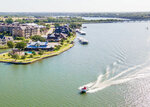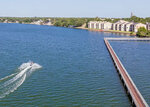

Wake zones on Lake Granbury have doubled in length, and Brazos River Authority Lake rangers will be educating the public for the next six weeks before handing out tickets to violators for the new law that went into effect on June 23.
The change doubles the length of a wake zone from 50 to 100 feet for boaters, and personal watercraft users who must not create a wake within 100 feet of the shoreline, boathouse, dock, or other structures.
The new law was first discussed during a March meeting of the BRA Board of Directors. A BRA news release cited proactivity as the main reason behind the new wake zone.
"The BRA is being proactive to the disturbances caused by boats traveling too fast and too close to docks. Lots of people enjoy our water supply reservoirs for a variety of activities. It is important everyone has the opportunity to remain safe while having fun."
The release also addressed slowing down.
"A no-wake speed is a headway speed that does not create a swell or wake. This means, if you're driving a boat or cruising on a personal watercraft, you need to hit the brakes sooner the closer you get to areas where people are swimming, resting on a dock, or enjoying the shoreline. Any boat can create a wake – or a wave created by the passage of the vessel – so don't think it's just the large boats that must take notice."
Lake rangers will be taking notice and will stop boaters and jet skiers if they see a violation. Tickets will still be issued for violating the 50-feet wake zone already in place.
Lake Granbury won't be dotted with a whole new array of orange and white buoys because the BRA is expecting boaters to know the rules without having signs everywhere that read "No-Wake Zones."
There were few public comments (21 over 30 days) about the proposed change, and after passing the new law, the BRA published notifications in local newspapers.
No-wake zones are nothing new to Texas reservoirs. And since 1975, the state has had laws within the Texas State Water Code regulating hazardous wake or wash for public safety. Per the Texas Water Safety Act law, a boat operator is always responsible for the wake caused by a boat until it flattens out. That is true for all watercraft, from PWCs to yachts, and especially wake-surfing crafts designed to generate large waves.
No-wake zones are used to mitigate hazards to boating safety. Hazards to boating safety include known navigational hazards such as narrow, shallow waters; areas of obstructed vision; structures in the area such as dams, trestles, power lines, and fueling docks; designated recreational or swimming areas; congested areas with high traffic (like marinas); or perhaps areas with a history of accidents.
A complete list of the current BRA regulations can be found online at brazos.org/About-Us/Reservoirs/Possum-Kingdom-Lake/Lake-Regulations.
Russell@hcnews.com | 817-573-7066 ext. 231